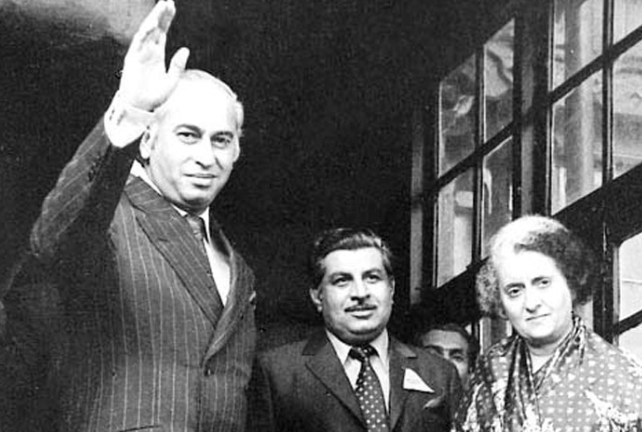Simla Agreement 1972 (GS Paper 2, India & Its Neighborhood)

Introduction
- On July 2, 1972, India and Pakistan signed the Simla Agreement, marking a significant milestone in their bilateral relations.
- This agreement, signed by Indian Prime Minister Indira Gandhi and Pakistan's President Zulfikar Ali Bhutto, aimed to establish peace and normalize relations between the two nations following the 1971 Indo Pakistani War.
- The 52nd anniversary of the Simla Agreement was recently observed, highlighting its enduring impact on South Asian geopolitics.
Origins and Context
Post 1971 War Dynamics:
- The Simla Agreement was a direct consequence of the 1971 Indo-Pakistani War, which resulted in the independence of Bangladesh (formerly East Pakistan).
- India's military intervention played a crucial role in this conflict, significantly altering the geopolitical landscape of South Asia.
Key Negotiators:
- The agreement was negotiated by Indian Prime Minister Indira Gandhi and Pakistan’s President Zulfikar Ali Bhutto.
- The primary aim was to establish lasting peace and normalize relations between the two countries after the intense hostilities.
Objectives of the Simla Agreement:
- Resolution of Kashmir Issue: India sought a bilateral resolution to the Kashmir dispute, aiming to restrain Pakistan from internationalizing the issue.
- Normalisation of Relations: India hoped to improve relations with Pakistan based on the new regional power balance.
- Avoiding Humiliation of Pakistan: India chose not to press for turning the ceasefire line into a permanent boundary to prevent further resentment and potential revanchism in Pakistan.
Key Provisions
Conflict Resolution and Bilateralism:
- The agreement emphasized resolving all issues between India and Pakistan through peaceful means, primarily through bilateral negotiations.
- It aimed to end the conflict and confrontation that had marred their relations.
Status of Kashmir:
- One of the most contentious issues addressed was the Line of Control (LoC) in Kashmir, established after the 1971 war.
- Both sides agreed to respect this line without prejudice to their respective claims and to refrain from altering its status unilaterally.
Withdrawal of Forces:
- The agreement stipulated the withdrawal of forces to their respective sides of the international border, marking a significant step towards de-escalation.
Future Diplomacy:
- The agreement laid down provisions for future meetings between the heads of both governments and ongoing discussions to establish durable peace, normalize relations, and address humanitarian issues like the repatriation of prisoners of war.
Significance
Geopolitical Tensions:
- The Simla Agreement remains relevant today as the Kashmir issue and broader IndoPak relations continue to be flashpoints in South Asian geopolitics.
Legal and Diplomatic Framework:
- It provides a legal framework for future discussions and negotiations between the two countries, despite its limitations and differing interpretations.
Criticism
Unfulfilled Potential:
- The Simla Agreement fell short of its intended goals of fostering lasting peace and cooperation between India and Pakistan.
- Deep-seated mistrust and historical grievances continue to hinder progress.
Nuclearisation and Strategic Shifts:
- Both countries conducted nuclear tests post1998, significantly altering the strategic calculus.
- This nuclear capability has led to a deterrence-based stability rendering the Simla agreement less relevant.
Long term Impact:
- Despite its intentions, the Simla Agreement did not lead to a sustained peace process or normalization of relations between India and Pakistan.
International Perspective:
- The international community generally respects the Simla Agreement's bilateral approach to resolving issues between India and Pakistan.
- It has often been cited to discourage international intervention in Kashmir.
How India-Pakistan Relations Have Been Over the Years
Partition and Independence (1947):
- The partition of British India into India and Pakistan in 1947 resulted in the creation of two separate nations.
- The Maharaja of Kashmir initially sought independence but eventually acceded to India due to Pakistan’s attack on Kashmir, which resulted in the first Indo-Pak War in 194748.
Wars, Agreements and Terror:
- 1965 and 1971 Wars: The 1965 war began with border skirmishes and escalated into a full-scale conflict, ending with a UN-mediated ceasefire and no major territorial changes. In 1971, India intervened in East Pakistan's struggle for independence, leading to the creation of Bangladesh.
- Simla Agreement (1972): Established the Line of Control (LOC) in Kashmir between India and Pakistan.
- Insurgency in Kashmir (1989): Pakistan supported a militant insurgency in Kashmir, leading to widespread violence and human rights abuses.
- Kargil War (1999): Pakistan-backed forces infiltrated Indian-controlled territory in Kargil, sparking a war that ended with an Indian military victory but strained relations further.
- Mumbai Attacks (2008): Pakistan-based Lashkar-e-Taiba militants launched coordinated attacks in Mumbai, killing 166 people. This event severely strained relations and led to international pressure on Pakistan to act against terrorism.
Current Situation (2023-2024):
- Continued political instability in Pakistan, coupled with ongoing militant activities and cross-border tensions, perpetuate the cycle of violence and distrust between the two nations.
- Geopolitical Dimensions: China's growing influence in the region, including its strategic partnership with Pakistan and territorial disputes with India, adds another layer of complexity to the Indo-Pakistani dynamic.
Conclusion
- The India-Pakistan conflict remains a complex and volatile issue with deep historical roots, intertwined with geopolitical rivalries, domestic politics, and aspirations for regional dominance.
- Efforts towards lasting peace face significant challenges amid recurring episodes of violence, militant activities, and mutual distrust.
- While the Simla Agreement of 1972 represented a significant effort towards peace between India and Pakistan after the 1971 war, its limitations and controversies underscore the complex and enduring nature of Indo-Pakistani relations.
- Its legacy remains pivotal in understanding the dynamics and challenges of South Asian diplomacy and security.


